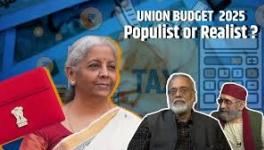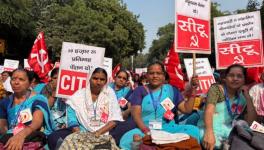Budget 2019-20 Belies Hopes of Urban People
The Union Budget presented by Finance Minister Nirmala Sitharaman, pegs growth of the economy at 8%. The target is to reach a GDP figure of $5 trillion ($ 5 lakh crore) by 2024. It will be a leap by 100% from the current GDP figures, which is about $ 2.5 trillion. The moot point is how does India achieve this growth.
One of the important sectors to ensure growth in the country is by investing in the cities. The cities presently contribute about 66% to the GDP and about 90% of total government revenues, whereas only 33% people live in cities. However, it is expected that by 2032, there will be 600 million (60 crore) people living in cities in India.
So, any desire to achieve a high growth rate and a high target must take into consideration this aspect of ‘development’ in cities. There are many factors that lead to growth in the cities. Land plays an important role. The IT industry is another sector that contributes to the growth in the cities. However, to make the cities sustainable to growth there must be a commensurate level of infrastructure. Take for example, if the city’s mobility starts crumbling then the people would prefer to find some other destination. Similarly, if the city is unable to provide safe drinking water, or is unable to manage its waste and sewage, the people will migrate out of the city. To sustain development in the city, the budget plays an important role. It acts like a tool to ensure that the development in the cities is sustainable.
Also watch: Union Budget: Who Gains, Who Loses?
The government of India through some of its flagship programmes and other projects like the Smart City Mission (SCM), Atal Mission for Rejuvenation and Urban Transformation (AMRUT), Swachh Bharat Mission (SBM) etc., provides a stimulus to urban development. Not to doubt that the cities themselves also have their own mechanism for development, but a majority of the cities through their own resources are not even able to meet the expenditure head of the city governments, let alone mobilise for capital formation.
Let us have a look at what the Union Budget has allocated to these schemes and what do they offer in the future. To achieve a high growth rate, there must be a higher allocation in the urban development sector. However, according to the budget figures on percentage of expenditure to the GDP, urban development continues to remain static at 0.23%. It means that actually there will be lesser spending in the year 2019-20 on urban development. With the figures of revised estimates falling and a fiscal deficit of over 3%, there will be lesser allocation on urban development. How and where these cuts will occur, only time will tell.
Let us also have a look at how has been the previous years’ spending on urban development. There were over 5,000 projects (mainly infrastructure), small and big, under the various schemes of urban development that were conceived in the last four years. However, only 897 projects are underway. An infusion of Rs 14, 847 crore has been made since SCM was announced, even though the target was to have an investment of over Rs 2 lakh crore. It is just about 7% of the desired investment. It has to be reiterated that smart city mission is one of the flagship programmes of the BJP government at the centre.
With this history of the past, the government has announced an investment of Rs 100 lakh crore in the next five years. This means Rs 20 lakh crore every year. A bulk of this investment will be for the construction of roads in the cities. The budget espouses to make the environment conducive for such an investment through an array of measures. The government has been boasting of its improved credentials in ‘ease of doing business’ index. This is to attract private investment, especially in the cities. Even in the past, for SCM and various other schemes, private public partnership (PPP) was and is still the model being eulogised. To attract private investment, the government boasts of creating a favourable environment. However, the past record suggests otherwise.
Under various schemes and projects in the cities, 21% of the investment was supposed to be from the private sector. However, only 15% of the desired 21% private investment took place in the last few years. Despite that, the budget still has high hopes on private investments in the cities. The flow of private investment in the cities has been mainly directed to network related development i.e., to construct ‘control command centres’ in smart cities rather than building core infrastructure. Hardly any city under the smart cities mission opted for a green field project.
Now, let us have a look at the sectoral allocation in some of the major schemes in urban development.
ALLOCATION FOR SCHEMES (in crore rupees)
| Scheme | 2018-19 | 2019-20 |
|---|---|---|
| Smart City Mission | 6169 | 6450 |
| AMRUT | 6400 | 7300 |
| SBM | 2500 | 2650 |
| PMAY | 6505 | 6853 |
As is evident from the table, the allocation has only seen a meagre rise which will have no positive impact taking into consideration the rate of inflation and the revised estimates, once tax collections are made. Under the PMAY, the budgetary allocation for economically weaker sections (EWS) and houses for lower income groups (LIG) has been cut from Rs 1,000 crore to Rs 600 crore. Besides, these figures are dependent on two basic requirements; (a) that there is a growth rate of 8% and (b) that tax collection increases commensurate to the desired growth rate.
GREEN BUDGET!
On the green budget , Down to Earth, a journal brought out by the Centre for Science and Environment, has stated, “The vision statement of India’s new Union Budget may have placed ‘Pollution-Free India with green mother earth and blue skies’ above ‘Make in India’ in the pecking order of vision goals, but it has not given any roadmap or moolah for National Clean Air Plan (NCAP).” Though the election promise was to put the NCAP on the mission mode to cut air pollution by 35% in next five years, the word ‘air pollution’ was missing from the budget speech.
The budget places the official position since April 2019 on the thrust towards e-vehicles. An approved outlay of Rs 10,000 crore is already in place since April 2019. However, without a legal framework and a commensurate increase in the creation of infrastructure for charging etc., this may hardly see any great advancement. In metro cities like Delhi still, the transformation from diesel and petrol to CNG is taking a lot of time. Despite a considerable period of installation of CNG stations, long queues are seen at these stations.
Also read: ‘Urban’ Vision in 2019 Manifestoes of Parties Leaves a Lot to be Desired
The budget also lacks prioritisation of mobility/transport sector in the cities. There is hardly any plan for bus-based urban transport system. The focus is on highly capital-intensive metro railway initiatives to be enhanced under PPP model. So far, the track record of private participation in metro initiatives has not been encouraging. Focus must be on comprehensive sustainable and affordable transport interventions.
The construction of the bullet train corridor from Ahmedabad will salvage more than 50,000 mangrove trees in a particular area. The Ministry of Environment, Forest and Climate Change MoEFC) budget has been reduced substantially and it does not even match the amount that it took to construct the statue of unity. Likewise, the NGT budget has also been cut by 42%.
VULNERABILITY OF THE URBAN POOR
The budget has completely failed to address the problems of the urban poor especially homeless, migrant workers and others engaged in the informal sector. According to the 2011 census, there are 139 million internal migrants (13.9 crore) in the country. These migrant workers have specific problems. Unfortunately, they are not even considered in the 74th constitutional amendment. Since a large number of these migrant workers live in slums, their issues of displacement, rehabilitation and provisions of basic services at their work place and habitation has not been looked into. One of the major demands that pertains to this section is the construction of workers hostels and houses on rent, since they cannot afford houses under the PMAY. There is no budgetary allocation for such activities. In fact, the vulnerability of the poor will increase with the implementation of the budgetary provisions.
Similarly, provision to regularise the street vendors and providing them with basic provisions have not been considered. Apparently, the government is more interested to evict the street vendors and is not interested in implementing the Street Vendors Act.
WATER TO EVERY HOUSE- STILL A DISTANT DREAM
Though the budget has mentioned about the provision to supply water to every house, a cursory look at the NITI Aayog document shows that 21 cities, and that includes, the national capital- Delhi and adjoining Gurugram and Faridabad will run out of ground water in one year. The other cities include Chennai, Bangalore, Indore, etc. The plan to provide water in these cities include capital intensive infrastructure building and fetching water from long distances. The effort to link and sync planning in cities along with water is completely missing. Instead of smart cities, the government should target smart water cities and try to revive the traditional and conventional water sources and ensure rain water harvesting.
Also read: Another Knee Jerk Reaction In The National Urban Policy Framework
The budget allocated for drinking water and sanitation is nearly Rs 20,000 crore which is a mere 0.11% increase than last year. There is no change in the allocation for cleaning under Namami Gange project, which was Modi government’s top priority in its first term.
There is also ambiguity over who will implement the water to every house project. In the cities, there is no uniformity either in the production or in the distribution of water. In majority of the cities, the production of water is by the parastatals whereas distribution is with the city governments. The slogan of water to every household by 2024 sounds good, but where is the water going to be pumped from is a big question which neither the government nor the budget is prepared to address.
Get the latest reports & analysis with people's perspective on Protests, movements & deep analytical videos, discussions of the current affairs in your Telegram app. Subscribe to NewsClick's Telegram channel & get Real-Time updates on stories, as they get published on our website.
























